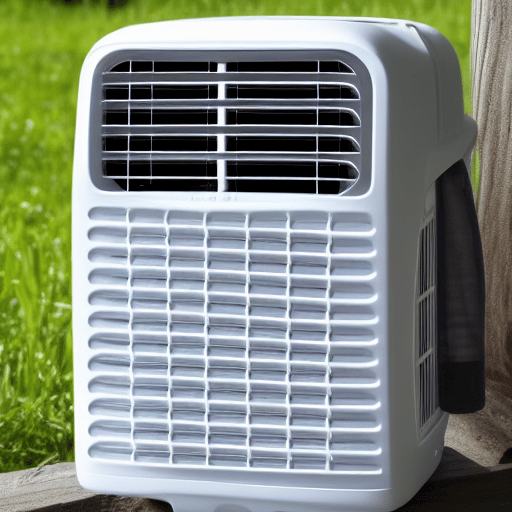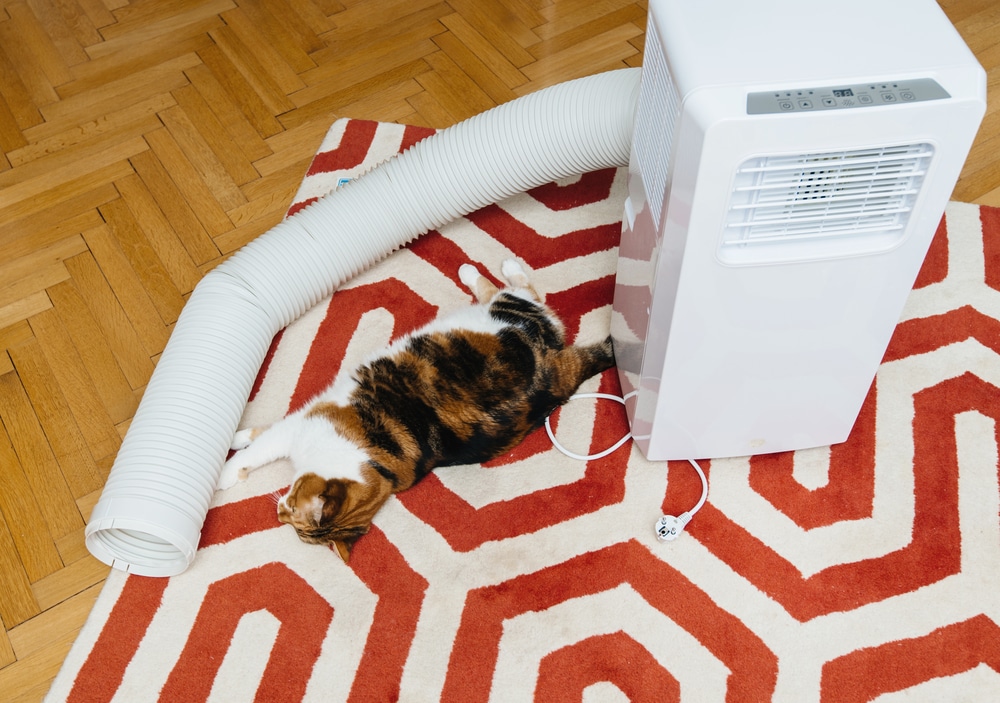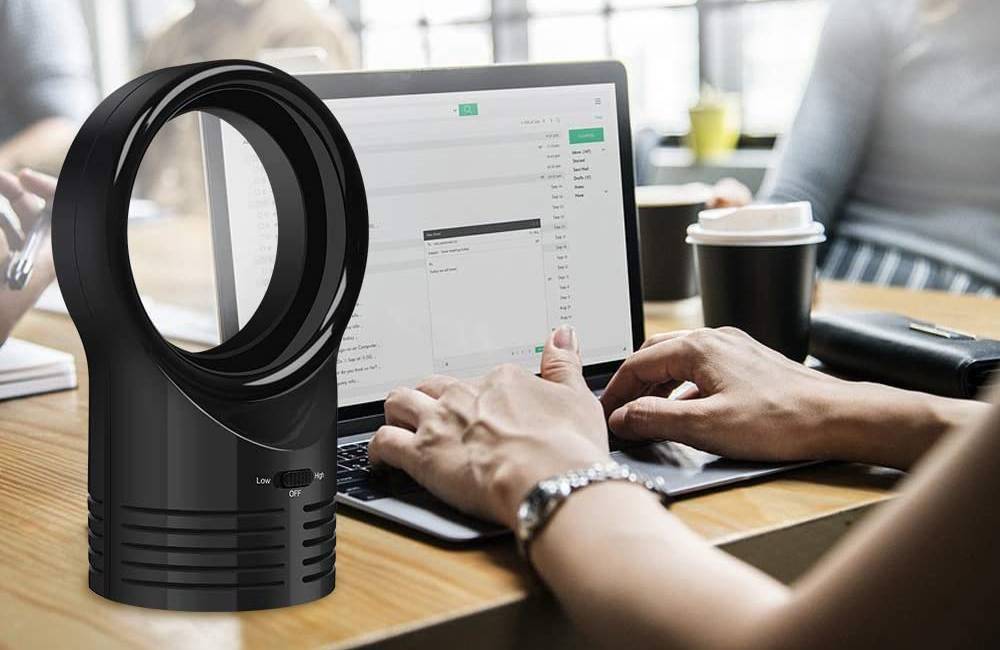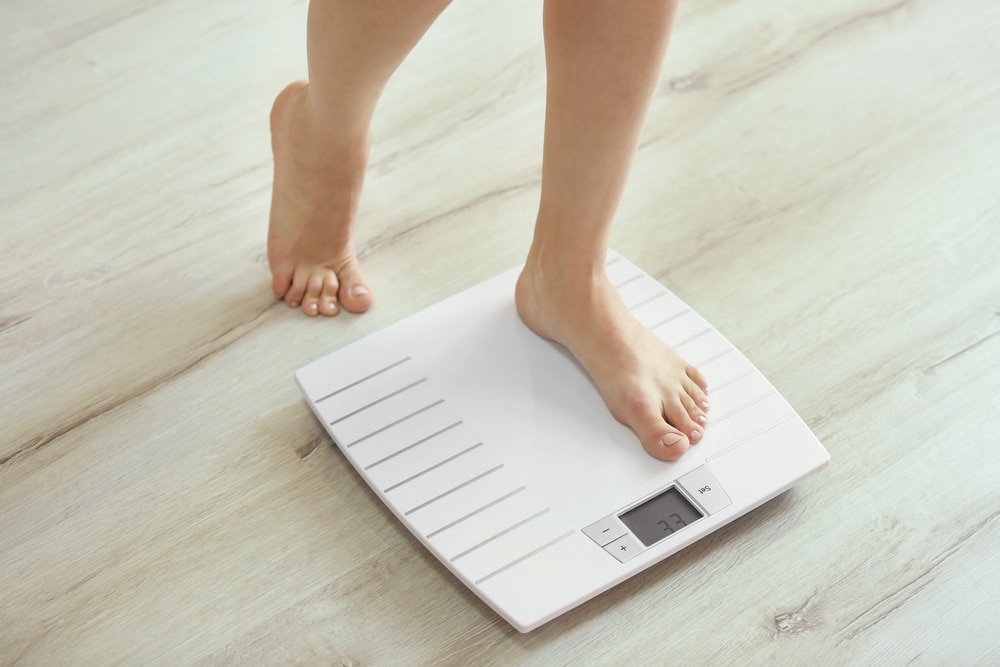Last Updated on
Wondering how to vent a portable air conditioner without a window? For best results, we’ll show you how to quickly get rid of hot air in this post.
If you have an aircon without a window, you’ll need to look for alternative ventilation methods. Below are some useful ways to vent a portable AC machine.
Ways to Vent a Portable AC
Through a Sliding Door
One of the most effective and efficient ways to vent a portable air conditioner and release the hot air or warm air in the room is by using a door. You can use both a hinged or a sliding door.
The ideal scenario for hinged doors is to open outwards and into the outdoors for the best venting of space. However, if you have a sliding door in your home, these are the best options. You can either adjust a window kit to suit your sliding door or buy a set that is specifically made for these types of doors. A sliding door set will usually come with three brackets that slide into each other and can be adjusted to fit the height of your door. Next, place the bracket to which you’ll attach the vent hose in between the other two brackets to ensure that the vent hole can be easily attached to the hose and vent the air conditioner.
If you want to install your AC in a room without a window or a door, a concerning factor may be that the hose needs to reach the desired room and area, therefore, ensure that your chosen product suits your measurements. You will find that many vent hoses exceed 10 feet.
Drop Ceiling
A ceiling vent isn’t common for most new homes but is often found in older homes with high ceilings. If you don’t have a high ceiling, you can usually rig it with an exhaust ceiling vent. Keep in mind that this may require a lot of time and various processes, including potentially cutting a hole large enough that can fit the AC’s exhaust pipe.
The last thing you want is your clients to get too hot in your conference room, but whether it's from many people in a small space, electronics, or large windows, that can be tough. A portable A/C unit can keep the conference room cool, and be mounted in the drop ceiling to be…
— Cool Zone A/C Inc. (@CoolZoneAC1) June 29, 2021
Through a Wall
Another common way to vent a portable air conditioner is through a wall. Best of all, you can install an exhaust system in a wall in virtually any type of property as a permanent ventilation system. However, before making a significant hole in your wall, you should think about how frequently you’ll use your portable air conditioner.
If you choose to add a venting system to a wall, bear in mind the number of wiring, plumbing, and studs involved in the installation process. You’ll also want to consider what a wall venting system might look like from the outside of your property. Additionally, remember that brick and stone are more difficult to channel through when compared to wood.
To seal the opening in the wall, you’ll need to use silicone caulk. To do this, place the tube with the nozzle facing the wall and begin applying the silicone caulk. Allow several hours for the material to dry once you’ve finished with the application and before you start using the AC unit.
Dryer Vent
Finally, there’s always the option of using a dryer vent without a window. You’ll need to insert the hose through the vent using a lot of force. Plus, make sure that the hole’s diameter is big enough to allow hot air to pass through with minimal effort.
Positioning a Portable Air Conditioner
Now that you know how to vent a portable air conditioner without a window, below are some tips for where and how to position your air conditioner without a window in your home.
Don’t Place it Near Sunlight

Some people often make the error of placing their portable air conditioner in direct sunlight. This can result in permanent damage as well as reduce the effectiveness of the machine. In addition, a portable air conditioner will become warmer if it’s exposed to sunlight, making it harder for it to operate and keep the air cool. An overheated AC unit can potentially cause the motor to burn out.
Therefore, ensure that the portable air conditioner is not placed in direct sunlight to achieve an optimal cooling effect. Otherwise, your unit might overheat and even stop working.
Keep the Exhaust Tube in Good Condition
Don’t just focus on the appearance of your portable air conditioner but focus on the condition of the exhaust hose. In which case, keep the exhaust hose straight and avoid any kinks, which could reduce the airflow. If kinks do occur, the venting system could slow down, impacting its effectiveness.
Clean the Filter
Keep the portable air conditioner’s filter clean. An unclean filter can attract hair, dust, and bacteria, causing the filter to become clogged with debris. Therefore, you should regularly clean and replace the air conditioner’s filter to improve air quality during use.
A dirty filter creates the ideal home for bacteria. Therefore, we recommend reading the instructions on how to keep your portable air conditioner in top form. You will find that you can gently vacuum the interior of the ventilation system to keep any dirt and dust away. Clean the portable air conditioner and replace the filters once a month – depending on how often you use it.
The Importance Of Venting a Portable Air Conditioner
Venting portable air conditioners is important to keep your room cool by removing hot air from the space. But to cool efficiently, the heat has to be removed from the room as the purpose of a portable ac is to cool down, but in order to do that, it must extract the hot air in the room. Otherwise, the portable air conditioner will have to work a lot harder venting.
How to Choose a Portable Air Conditioner
There are so many benefits of owning a portable air conditioner—such as improving the air quality, reducing dehydration, enhancing your concentration and productivity, and providing you with a cooler and allergy-free living space.
Below are some important factors to look at and consider when buying your unit.
Noise Level
Air conditioner units can be noisy when in use, and, unfortunately, we haven’t been able to find a completely silent mode during operation. However, 50 dB is a low noise level to consider, making it great for use when you’re sleeping or if you want to work without any disturbances. If a quiet operation is an important factor for you, bear in mind that you may need to increase your budget.
Finally got myself a top quality mounted airconditioner in my streaming room.
— WackyJacky101 (@WJacky101) August 21, 2019
No more having to choose between sitting in 65db noise (portable a/c) or 30+ degree celcius!
Cooling Capacity
Another important factor to consider when looking into portable air conditioners is their cooling capacity. Measured using British Thermal Units (BTU), a portable AC should have a minimum of 7,000 BTU for a living space of up to 15m².
Programmer
If you like the idea of arriving home and your portable air conditioner has already started to operate without you pressing a button, you might want to consider a unit with programmable settings. This scheduling function can also help to reduce your electricity bill. Above all, high-end portable Air Condition units provide a delayed start, allow you to set cycles, adjust temperature settings, and much more.
Energy Consumption
A portable air conditioner can be energy-efficient. Look for a unit with an energy consumption of A to G. Ideally, an AC unit with an energy rating of A to A++ is the best to reduce the outgoing cost.
New hot and cold cruise portable ac easy to move…best from heater low power consumption
— shahzad Alam (@shohiali) September 5, 2019
Carbon Filter
Don’t just keep a room in your home cool but keep your home safe with a carbon filter. These types of filters effectively remove odours, bacteria, and dust. This is ideal if people in your household have allergies or respiratory problems. There are even additional filters available that are built into these appliances to provide a safer indoor environment.
Design
Portable air conditioners are available in various sizes and styles, and you must choose a unit that fits your living space. So if you only have a small amount of spare space in your living room, you’ll need a smaller unit that won’t get in the way. If you plan to move the portable AC into different rooms, consider a machine with built-in wheels that make it easier to move it around your home.
Caring for Your Portable Air Conditioner
Portable air conditioners are a great addition to your home, and below are some useful caring and maintenance tips for using these units in your living space.
Clean Filters
Keep your unit’s filters clean and in tip-top condition by cleaning the filters every month (depending on how often you use your portable air conditioner). Ideally, these filters will need to be replaced instead of just cleaned. In this case, you might want to consider the ease of replacing and buying these filters during the initial buying process.
How to Clean Air Conditioner Coils Properly | Cool And Portable https://t.co/BhIvf3cx85 pic.twitter.com/DuusfcRAiY
— Cool And Portable (@coolandportable) July 31, 2020
Drain the Water
Portable air conditioners collect water from the air to keep the units cool. Unfortunately, most portable air conditioning units feature an internal tank that collects condensation, so you may need to empty it quite regularly.
Clean the Exterior
Keeping your portable air conditioner’s exterior clean and tidy is important. Therefore, we recommend wiping down the unit’s exterior every couple of weeks. Ensure that the unit is switched off before doing so, and avoid using any abrasive cleaners on the surface that could damage the surface and functioning of the portable air conditioner.
Inspect the Coils
When undergoing the portable air conditioner’s maintenance, check the condenser coils are working properly because purchasing new ones can be expensive. In addition, condenser coils get dirty with every use and can experience a buildup of grease and grime. Therefore, you’ll need to check the portable air conditioning unit for gunk and debris.
The coils and vents of both window and portable #AirConditioner units need to be cleaned periodically. A plastic scrub brush can be used to remove dirt from a room air conditioner.
— AHAM (@AHAM_Voice) March 6, 2020
A Cool Breeze
As you can see, there are several ways on how to vent a portable air conditioner without a window, including through a drop ceiling, a wall, and doors. Hopefully, the article has given you a few ideas of how you can install your unit. And, if you have any additional methods for venting your AC unit without a window, let us know your tips and tricks in the comments.
Amy is a U.K.-based writer and editor with a penchant for helping consumers find the best home products for their needs, as well as providing easily digestible guides for living better at home. Her dedication to her work means she can usually be found elbow-deep in research or hunting down samples of the latest and greatest on behalf of her readers.
An avid DIYer herself, Amy’s passion lies in teaching others how they too can achieve their dream homes by tackling some of those pesky projects themselves! Whether it’s building furniture from scratch or turning an old dresser into a coffee table, Amy is always happy to share what she knows about making your house feel like home without spending a fortune.



